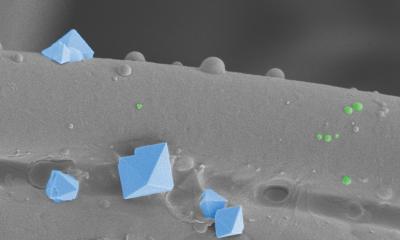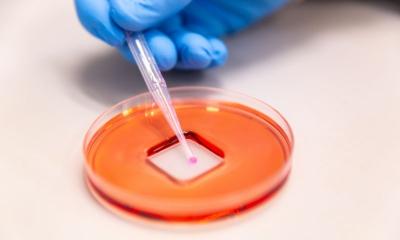© Thaut Images – stock.adobe.com
News • MCMV based approach
Covid-19: vector vaccine offers long-term protection
HZI researchers use mouse virus as a vehicle for the spike protein for an improved immune response
The protective effect of established Covid-19 vaccines is initially very robust, but wanes relatively quickly. This limitation imposes a need for periodic booster shots, which drives vaccine hesitation. In contrast, an innovative vector vaccine developed at the Helmholtz Centre for Infection Research (HZI) presents a compelling alternative. It elicits prolonged immune response in animal models, and maintains its efficacy over extended time. The concept employs an animal cytomegalovirus (MCMV; murine cytomegalovirus) as the vector that expresses and delivers the coronavirus spike protein information. Crucially, this vector poses no threat to humans, enhancing the vaccine's safety profile.
The researchers present their findings in the journal Frontiers in Immunology.
In 2022, researchers from the department “Viral Immunology” headed by Prof. Luka Cicin-Sain at the Helmholtz Centre for Infection Research reported on the novel vector vaccine for the first time. The promising immunogenic profile of the MCMV-based vaccine has now been shown to protect against disease. A recent publication with the involvement of national and international research partner institutions, such as the Max Delbrück Center in Berlin and the University of Rijeka in Croatia, demonstrates lasting and broad immune responses and antiviral protection in the mouse model.
Using an animal cytomegalovirus that cannot replicate in human cells as a vector is a clever move, because it combines high immunogenicity of a natural infection with the safety of a non-replicating vector. In vector vaccines, viruses are used as vehicles to introduce building blocks of the pathogen against which the vaccination is directed into the human body. In vaccines against Covid-19, the gene for the blueprint of the spike protein that anchors the coronavirus to the host cells is integrated into the vector viruses.
Recommended article

Article • Covid-19
Coronavirus update
Years after the first outbreak and spread of coronavirus Sars-CoV-2, its impact can still be felt in everyday life. Keep up-to-date with the latest research news, political developments, and background information on Covid-19.
There are reasonable concerns about the safety of vaccines based on some vector viruses. Human viruses that are used as vectors have to be attenuated by genetic modifications. The MCMV, however, can be used as is, because cytomegaloviruses are highly host-selective. This means that the MCMV can only replicate in mouse cells, but not in human ones, as two of the first authors, Dr. Kristin Metzdorf and Dr. Henning Jacobsen, explain. For this reason, among others, MCMV is ideal as a vector for vaccines.
The researchers see the big advantage in the long-lasting vaccination response that can be achieved with the MCMV vaccine after just one dose. Using an animal model, it was shown that the concentration of antibodies available for defense against the pathogen in the event of a subsequent infection with the Sars-CoV-2 coronavirus remains stable over a period of six months after vaccination. Results from research colleagues at the University of Rijeka in Croatia suggest that the protective effect lasts even longer.
The immune system takes a two-pronged approach to fighting pathogens: firstly, highly specific antibodies are formed that are directed against defined structures of the microbe and render it harmless. The second track consists of the mobilization of immune cells that specifically recognize infected cells and actively fight the pathogens in them. So-called CD8+ T cells play the central role here. After vaccination with the MCMV vaccine against Covid-19, the antibodies circulating in the blood and CD8+ T cells directed against infected cells are permanently present and ready for action.
Research about the reasons for the lasting protective effect of MCMV vaccines are ongoing. A plausible explanation is that cytomegaloviruses restimulate immune cells for a long time by hiding in a mostly dormant mode in cellular niches of their host, a state known as latency. Only when the host organism's immune defenses weaken the viruses switch to the active mode, replicate and spread, causing signs of illness. The MCMV vector viruses presumably will also try to settle in the human organism, but because humans are not the right host for them, reactivation does not work. The human immune system does not allow murine viruses to reappear in the blood and takes action against them as soon as they produce proteins and before infectious particles are formed. In this way, according to the theory, the immune defense is repeatedly stimulated and the vaccination effect is maintained.
And there is one more thing. Coronavirus immunity does not only wane due to the loss of immune cells, but also because the viruses mutate to escape immune recognition by antibodies. MCMV vaccines keep this evolution in check, at least in part. The researchers used the spike gene of the very first Sars-CoV-2 variant for the new vaccine. Upon vaccination with the MCMV vaccine, specific antibodies were initially formed against the original spike protein, which was expected. However, some months after vaccination, antibodies against Sars-CoV-2 variants such as the Omicron started to form and increase in number. This is probably due to a mechanism of the immune system that serves to increase resistance to attackers through mutations (genetic changes) in the relevant immune cells. According to the researchers, the fact that this mechanism is particularly well supported by the MCMV vaccine is a further advantage of this technology.
The favorable all-round profile of the MCMV vector is completed by its high capacity to take up foreign genes. These are exchanged for virus genes that are not essential for the integrity of the virus. Theoretically, it is possible to introduce several different genes of a pathogen into the MCMV at the same time and thus increase the vaccination effect or the activity spectrum against variants. It is also conceivable to use this vector to produce combination vaccines that provide immunity against various diseases in one go. The combined vaccination against Covid-19 and influenza would be a useful example.
Source: Helmholtz Centre for Infection Research; author: Ulrike Viegener
29.08.2024











